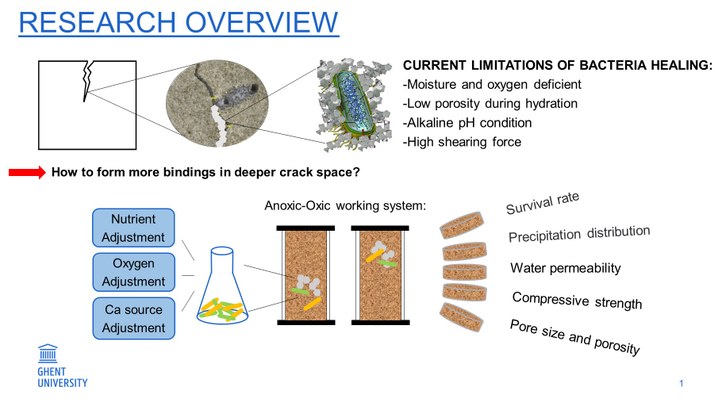Autonomous self-healing by multiple bacterial metabolic pathways
Researchers:
- Xuejiao Zhu
- Nico Boon (supervisor)
- Nele De Belie (supervisor)
Description:
Cracks are intrinsic concrete characteristics which will endanger the durability of concrete structures. Annually, refurbishment and repair of existing structures takes about 50% of Europe’s construction budget and this figure is expected to increase as the major population of concrete structures built in the 1960s and 1970s in reaching the end of the design service life. The formation of cracks in concrete may not only endanger the structure stability, but also will cause the ingress of water and gas, leading to a range of matrix degradation as well as corrosion of the embedded steel reinforcement. Therefore, concrete cracks repairing is of significance to maintain the healthy state of the structure and prevent durability issues. Since 2007 when microbial induced calcite precipitation (MICP) as a biological approach, was firstly applied in concrete autonomous self-healing, numerous research teams worldwide has started research on this topic. However, till so far, there still remain some deficiencies and challenges about this technology. For instance: (1) Homogenous calcite precipitation as consequence of an efficient MICP process can’t be guaranteed as the sustainable growth of aerobic bacteria was only discovered in the near surface zone of cracks, mainly due to the oxygen-deficient environment, high gravitational potential pressure and lack of enough living space for bacteria to survive in the deeper area. (2) The MICP process is dominated by bacteria species mostly based on single metabolic pathways such as urea hydrolysis, denitrification, sulphate reducing and organic carbon consumption, such metabolic pathways widely exist among microorganisms in nature and so far, multiple metabolic pathways haven’t been studied for the enhancement of bacteria CaCO3 producing. (3) The crack healing mechanism and development of bounding agents inside crack zone need to be further studied in order to understand its comprehensive effect on mortar durability related to properties such as water permeability and compressive strength.
